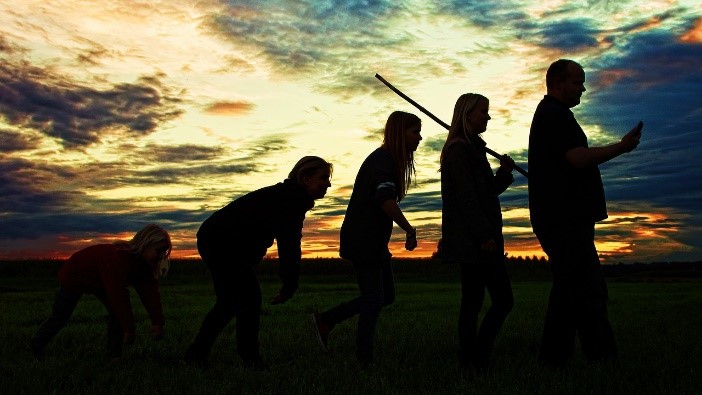Articles and Additional Material
Re-member
by Koralia Timotheou*
 Researchers believe that until fifty thousand years ago, the Earth had been home to six distinct humanoid species[i]. We are thought to be the descendants of one of them: Homo-Sapiens. One of our long-gone cousins, the Neanderthal, co-existed with us during our early years. They were then extinct, probably due to their lack of adaptability and the animosity among species, but perhaps we have kept a memento from them, hidden in our genes.
Researchers believe that until fifty thousand years ago, the Earth had been home to six distinct humanoid species[i]. We are thought to be the descendants of one of them: Homo-Sapiens. One of our long-gone cousins, the Neanderthal, co-existed with us during our early years. They were then extinct, probably due to their lack of adaptability and the animosity among species, but perhaps we have kept a memento from them, hidden in our genes.
One of the most significant differences between Homo-Sapiens and the Neanderthal is our brain structure[ii]. Since the beginning, Homo-Sapiens had the brain capacity for creative thinking and problem-solving. This made us adaptable and is one of the reasons we are still here. The Neanderthal’s brain was slow to generate new ideas and had difficulty putting things together to arrive to complex conclusions. This came at a cost. Neanderthals couldn’t progress as fast as Homo-Sapiens did. They were outsmarted and defeated.
Nevertheless, they were not without gifts. Researchers speculate that they had a very different kind of intelligence: a more acute sensory ability and perhaps a different kind of memory. It is possible that a large part of their brain was an ancient database where the memories of their ancestors were accumulated and stored. Each individual had access to the basic skills and knowledge of many generations who preceded them. This is an extraordinary ability. It meant that they could access, recover, and use information and knowledge already stored within them without ever being actively taught or explicitly instructed. They could remember. Unfortunately for them, they were so slow in adding new entries to this vast databank that they did not progress fast enough to ensure their survival.
This and other findings have urged some anthropologists to re-examine our relationship with ancient humanoids and neuroscientists to investigate the capacity of our own species to access pre-stored data: information that comes along with the hardware, our human body, and is probably stored in the cloud. It is still debatable whether we are pure Homo-Sapiens descendants. Since our coexistence with other primates is confirmed, it is more than possible that some of the Neanderthal has been preserved within us[iii], and we, too, can access their built-in databank. This would explain some inherited dexterities and talents such as artistic skills and craftsmanship.
Philosophers, spiritual people, and many scientists across cultures insist that all we need, we already have inside. This need not be a metaphor. Turning inwards, we can perhaps gain access to information and skills our ancestors have mastered throughout our collective journey on the Planet. Combining our brain’s creative ability for technological advancement and a continuous flow of innate deep wisdom, we can, individually and jointly, create wonders.
Remembering is for those who have forgotten.
Plotinus
 To re-member is to tune inside in order to connect with what lies outside of us; to re- become an indivisible member of the human family, the Earth, the Universe, and the Cosmos; an integral part of the whole; to reclaim our inherent gifts and make use of our legacy; to be aware of all that is at our disposal.
To re-member is to tune inside in order to connect with what lies outside of us; to re- become an indivisible member of the human family, the Earth, the Universe, and the Cosmos; an integral part of the whole; to reclaim our inherent gifts and make use of our legacy; to be aware of all that is at our disposal.
***
* Koralia Timotheou is the author of Re-story, Restore, Restart, a self-development book designed to assist you in broadening your perception, healing sub-conscious wounds and moving forward, co-creating your future.
Click for the book, website, facebook
[i] HARRARI Y.N. (2020) Sapiens – The birth of humankind. London: Penguin Random House
[ii] https://theconversation.com/human-and-neanderthal-brains-have-a-surprising-youthful-quality-in-common-new-research-finds-191594
[iii]https://www.worldhistory.org/Homo_Sapiens/#:~:text=Genetically%2C%20we%20are%20not%20a,extinct%20human%20species%3A%20the%20Denisovans.

